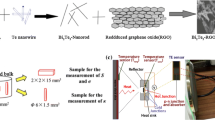Abstract
The memristive properties of Cu/nanocomposite/ LiNbO3/Cu capacitor structures based on a (Co40Fe40B20)x(LiNbO3)100 – x nanocomposite and an amorphous LiNbO3 interlayer with thicknesses of about 40 and 20 nm, respectively, have been studied. It was found that these structures have relatively low resistive switching voltages (~2 V) and are capable of withstanding more than 104 cyclic switchings due to the formation of conducting channels in LiNbO3 in fixed regions specified by the position of percolation chains of CoFe nanograins in the nanocomposite. It is shown that the conductance of Cu/nanocomposite/LiNbO3/Cu memristors can vary according to local biosimilar rules. A simple neural network based on such memristors, trained by feeding a frequency-coded noise signal to its inputs, was implemented.



Similar content being viewed by others
REFERENCES
K. Berggren, Q. Xia, K. K. Likharev, D. B. Strukov, H. Jiang, T. Mikolajick, D. Querlioz, M. Salinga, J. R. Erickson, S. Pi, F. Xiong, P. Lin, C. Li, Y. Chen, S. Xiong, et al., Nanotechnology 32, 012002 (2021). https://doi.org/10.1088/1361-6528/aba70f
S. Shchanikov, A. Zuev, I. Bordanov, S. Danilin, V. Lukoyanov, D. Korolev, A. Belov, Y. Pigareva, A. Gladkov, A. Pimashkin, A. Mikhaylov, V. Kazantsev, and A. Serb, Chaos Solit. Fract. 142, 110504 (2021). https://doi.org/10.1016/j.chaos.2020.110504
V. V. Rylkov, A. V. Emelyanov, S. N. Nikolaev, K. E. Nikiruy, A. V. Sitnikov, E. A. Fadeev, V. A. Demin, and A. B. Granovsky, J. Exp. Theor. Phys. 131, 160 (2020). https://doi.org/10.1134/S1063776120070109
M. Prezioso, F. Merrikh-Bayat, B. D. Hoskins, G. C. Adam, K. K. Likharev, and D. B. Strukov, Nature (London, U.K.) 521, 61 (2015). https://doi.org/10.1038/nature14441
C. Li, Z. Wang, M. Rao, D. Belkin, W. Song, H. Jiang, P. Yan, Y. Li, P. Lin, M. Hu, N. Ge, J. P. Strachan, M. Barnell, Q. Wu, R. S. Williams, J. J. Yang, and Q. Xia, Nat. Mach. Intell. 1, 49 (2019). https://doi.org/10.1038/s42256-018-0001-4
J. Moon, W. Ma, J. H. Shin, F. Cai, C. Du, S. H. Lee, and W. D. Lu, Nat. Electron. 2, 480 (2019). https://doi.org/10.1038/s41928-019-0313-3
K. E. Nikiruy, A. V. Emelyanov, V. A. Demin, A. V. Sitnikov, A. A. Minnekhanov, V. V. Rylkov, P. K. Kashkarov, and M. V. Kovalchuk, AIP Adv. 9, 065116 (2019). https://doi.org/10.1063/1.5111083
A. N. Matsukatova, A. V. Emelyanov, A. A. Minnekhanov, A. A. Nesmelov, A. Yu. Vdovichenko, S. N. Chvalun, V. V. Rylkov, P. A. Forsh, V. A. Demin, P. K. Kashkarov, and M. V. Kovalchuk, Appl. Phys. Lett. 117, 243501 (2020). https://doi.org/10.1063/5.0030069
J. H. Ryu and S. Kim, Chaos Solit. Fract. 140, 110236 (2020). https://doi.org/10.1016/j.chaos.2020.110236
D. Querlioz, O. Bichler, P. Dollfus, and C. Gamrat, IEEE Trans. Nanotechnol. 12, 288 (2013). https://doi.org/10.1109/TNANO.2013.2250995
S. Brivio, D. Conti, M. V. Nair, J. Frascaroli, E. Covi, C. Ricciardi, G. Indiveri, and S. Spiga, Nanotechnology 30, 015102 (2019). https://doi.org/10.1088/1361-6528/aae81c
V. A. Demin, D. V. Nekhaev, I. A. Surazhevsky, K. E. Nikiruy, A. V. Emelyanov, S. N. Nikolaev, V. V. Rylkov, and M. V. Kovalchuk, Neural Networks 134, 64 (2021). https://doi.org/10.1016/j.neunet.2020.11.005
A. Serb, J. Bill, A. Khiat, R. Berdan, R. Legenstein, and T. Podromakis, Nat. Commun. 7, 12611 (2016). https://doi.org/10.1038/ncomms12611
A. V. Emelyanov, K. E. Nikiruy, A. V. Serenko, A. V. Sitnikov, M. Yu. Presnyakov, R. B. Rybka, A. G. Sboev, V. V. Rylkov, P. K. Kashkarov, M. V. Kovalchuk, and V. A. Demin, Nanotechnology 31, 045201 (2020). https://doi.org/10.1088/1361-6528/ab4a6d
Q. Xia and J. J. Yang, Nat. Mater. 18, 309 (2019). https://doi.org/10.1038/s41563-019-0291-x
M. Prezioso, M. R. Mahmoodi, F. M. Bayat, H. Nili, H. Kim, A. Vincent, and D. B. Strukov, Nat. Commun. 9, 5311 (2018). https://doi.org/10.1038/s41467-018-07757-y
S. Choi, S. H. Tan, Z. Li, Y. Kim, C. Choi, P.-Y. Chen, H. Yeon, S. Yu, and J. Kim, Nat. Mater. 17, 335 (2018). https://doi.org/10.1038/s41563-017-0001-5
M. N. Martyshov, A. V. Emelyanov, V. A. Demin, K. E. Nikiruy, A. A. Minnekhanov, S. N. Nikolaev, A. N. Taldenkov, A. V. Ovcharov, M. Yu. Presnyakov, A. V. Sitnikov, A. L. Vasiliev, P. A. Forsh, A. B. Granovsky, P. K. Kashkarov, M. V. Kovalchuk, and V. V. Rylkov, Phys. Rev. Appl. 14, 034016 (2020). https://doi.org/10.1103/PhysRevApplied.14.034016
W. Banerjee, Q. Liu, and H. Hwang, J. Appl. Phys. 127, 051101 (2020). https://doi.org/10.1063/1.5136264
ACKNOWLEDGMENTS
The research was carried out using the equipment of the Resource Center for Electrophysical Methods of National Research Center “Kurchatov Institute”.
Funding
This work was supported in part by the Russian Science Foundation (grant no. 20-79-10185) in the study of the electrophysical and structural properties of memristive samples and by Russian Federation Presidential Grant MK-2203.2021.1.2 in the part of training a spiking neural network with noise signals.
Author information
Authors and Affiliations
Corresponding author
Ethics declarations
The authors declare that they have no conflicts of interest.
Additional information
Translated by E. Chernokozhin
Rights and permissions
About this article
Cite this article
Il’yasov, A.I., Emel’yanov, A.V., Nikirui, K.E. et al. Frequency-Coded Control of the Conductance of Memristors Based on Nanoscale Layers of LiNbO3 and (Co40Fe40B20)x(LiNbO3)100 – x Composite in Trained Spiking Neural Networks. Tech. Phys. Lett. 47, 656–660 (2021). https://doi.org/10.1134/S1063785021070075
Received:
Revised:
Accepted:
Published:
Issue Date:
DOI: https://doi.org/10.1134/S1063785021070075




